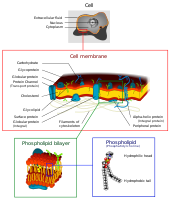
Photo from wikipedia
Mycobacterium tuberculosis (Mtb) serves as the epitome of how lipids-next to proteins-are utilized as central effectors in pathogenesis. It synthesizes an arsenal of structurally atypical lipids (C60-90) to impact various… Click to show full abstract
Mycobacterium tuberculosis (Mtb) serves as the epitome of how lipids-next to proteins-are utilized as central effectors in pathogenesis. It synthesizes an arsenal of structurally atypical lipids (C60-90) to impact various membrane-dependent steps involved in host interactions. There is a growing precedence to support insertion of these exposed lipids into the host membrane as part of their mode of action. However, the vital role of specific virulence-associated lipids in modulating cellular functions by altering the host membrane organization and associated signaling pathways remain unanswered questions. Here, we combined chemical synthesis, biophysics, cell biology and molecular dynamics simulations to elucidate host membrane structure modifications and modulation of membrane-associated signaling using synthetic Mtb sulfoglycolipids (SL). We reveal that Mtb SL reorganizes the host cell plasma membrane domains while showing higher preference for fluid membrane regions. This rearrangement is governed by the distinct conformational states sampled by SL acyl chains. Physicochemical assays with SL analogs reveal insights into their structure-function relationships highlighting specific roles of lipid acyl chains and head group along with effects on autophagy and cytokine profiles. Our findings uncover a mechanism whereby Mtb uses specific chemical moieties on its lipids to fine-tune host lipid interactions and confer control of the downstream functions by modifying the cell membrane structure and function. These findings will inspire development of chemotherapeutics against Mtb by counteracting their effects on host-cell membrane.
Journal Title: ACS chemical biology
Year Published: 2020
Link to full text (if available)
Share on Social Media: Sign Up to like & get
recommendations!